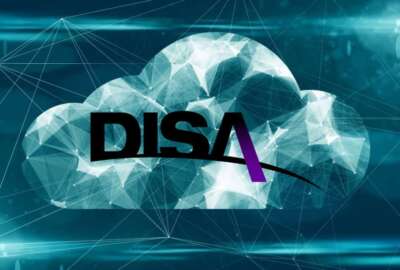
DoD orders applications in more than 100 data centers to move to DISA’s milCloud
A May 7 memo from the Defense Department's chief information officers gives "fourth estate" agencies until 2020 to migrate applications from more than 100 data...
The Pentagon has ordered Defense organizations that operate more than 100 of its data centers to begin migrating their applications to milCloud 2.0, the new on-premises commercial cloud service managed by the Defense Information Systems Agency.
In a May 3 memo, signed by then-DoD Chief Information Officer Essye Miller, the department listed a total of 105 data centers that will be affected by the mandate. Each are operated by DoD “fourth estate” agencies, including the Defense Logistics Agency, the Defense Finance Accounting Service, the Defense Health Agency, DARPA and the Joint Chiefs of Staff.
According to the directive, which was first reported by NextGov, Defense agencies have until March 2019 to move systems that have already been virtualized into milCloud. The rest of the workloads have a later deadline, September 2020, in order to give their operators time to get them “cloud ready.” The mandate also applies to systems that are already hosted in DISA data centers, but are in legacy environments that are not part of milCloud.
Heather Babb, a Pentagon spokeswoman, framed the wave of milCloud migrations as part of Defense Secretary James Mattis’ business reform initiative.
“DoD is committed to providing the warfighter with an information environment that transforms data into actionable information rapidly and efficiently,” she said in a statement to Federal News Radio. “That’s why we are accelerating the optimization of DoD’s information technology infrastructure with a focus on cloud adoption and data center consolidation as part of DoD’s reform activities. The DoD CIO has directed fourth estate systems to migrate to milCloud 2.0 with the outcome of reducing the Department’s data center footprint and streamlining data center infrastructure.”
milCloud 2.0 is the contractor-operated follow on to DISA’s original cloud offering, which is operated largely by government personnel. The 2.0 edition, run within DISA’s data centers by General Dynamics Information Technology, first came online in February and is beginning to onboard “early adopters.”
DISA, which has also ordered that all of its own internal applications migrate to milCloud 2.0, says the new service differs from the original version in several key ways, including how the agency bills DoD customers for its services. It uses a pay-per-use model similar to the ones used by commercial cloud providers, and that DISA says will be cost-competitive with those same providers.
“And transparency was another big goal for us in this iteration,” said Caroline Bean, DISA’s milCloud program manager, in an interview with Federal News Radio. “Mission partners are able to view the health and utilization metrics of their virtual environment in near real-time, and program managers have the capability to monitor their funding utilization from the milCloud 2.0 business portal. So these self management tools and reports allow the application owners to make informed decisions about their programs’ utilization and funding all in near real time.”
The agency also expects the new version of milCloud to be approximately 70 percent less expensive than the original offering, Bean said.
“Since it’s a commercial service provider that operates and owns the infrastructure, the government is actually able to take advantage of the economies of scale and benefit from the efficiencies that industry has, since they’re running the cloud operations for us,” she said. “The second reason it’s less expensive is because the infrastructure utilizes open source software, which means you don’t have the additional licensing costs required to run the capability. So essentially we’re able to pass those savings onto our mission partners as well.”
Latest Defense News
According to Miller’s memo, DISA is already coordinating with agencies whose systems are already housed in the agency’s data centers on how to transition to the milCloud offering. The DoD CIO also plans to hold off-site “data collection sessions” with the fourth estate agencies to discuss the specifics of the systems that will be impacted and how the migrations will proceed.
DISA’s contract with GDIT, aside from its base Infrastructure-as-a-Service and Platform-as-a-Service offerings, also includes transition services the fourth estate agencies that are migrating might choose to use.
“That includes design and engineering services as well as conducting app rationalization, which is a crucial step for mission partners who are looking for cost savings within their programs,” Bean said. “So we can essentially assist in the packaging and moving of data into milCloud 2.0. We can essentially do as little or as much as the mission partner prefers when it comes to transition support.”
Precisely how the newly-directed milCloud migrations will interplay with the department’s plans for its upcoming JEDI contract remains unclear.
That single-award project, for off-premises IaaS and PaaS cloud services, is expected to move into the final solicitation stage sometime this week. But in a May 7 report to Congress, Defense officials said JEDI would be “complementary” to other enterprise-wide DoD cloud offerings, including milCloud and DISA’s forthcoming Defense Enterprise Office Solutions (DEOS).
“milCloud 2.0 provides an immediate on-premises solution that will enable components to reduce hosting costs relative to legacy data storage for applications that are ready for migration to the cloud,” officials wrote. “The DoD is working with user groups to prioritize which will move to milCloud 2.0, starting with Defense agencies and field activities.”
Copyright © 2025 Federal News Network. All rights reserved. This website is not intended for users located within the European Economic Area.
Jared Serbu is deputy editor of Federal News Network and reports on the Defense Department’s contracting, legislative, workforce and IT issues.
Follow @jserbuWFED
Related Stories

Public, private, MilCloud: DISA tool makes the cloud decision easier





